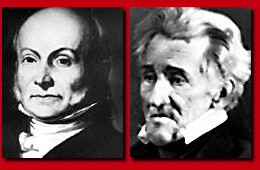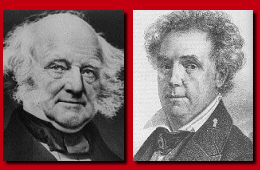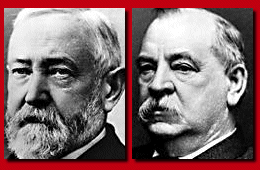|
|

 Enemy of the Republic
Enemy of the Republic
A partial list of electoral college-based blunders & near disasters
-
 1800 - Democratic-Republican Thomas Jefferson ran against incumbent Federalist John Adams. The Democratic-Republicans chose powerful New Yorker Aaron Burr as Jefferson's running-mate. When Jefferson and Burr defeated the Federalists, the electoral college convened to elect the duo. The Democratic-Republicans' plan did not work as planned, though, because each elector voted for Jefferson and Burr, and, with 73 votes each, the election went to the House. The House, which the Democratic-Republicans had swept along with the presidency in the "Revolution of 1800," remained under Federalist control prior to inauguration day. Although Jefferson was clearly supposed to have won the election, Burr refused to endorse him. He was finally elected on the 36th ballot, when Alexander Hamilton intervened on the behalf of Jefferson, and the republic. (Burr later killed Hamilton.) Burr was named VP, as per the original plan.
1800 - Democratic-Republican Thomas Jefferson ran against incumbent Federalist John Adams. The Democratic-Republicans chose powerful New Yorker Aaron Burr as Jefferson's running-mate. When Jefferson and Burr defeated the Federalists, the electoral college convened to elect the duo. The Democratic-Republicans' plan did not work as planned, though, because each elector voted for Jefferson and Burr, and, with 73 votes each, the election went to the House. The House, which the Democratic-Republicans had swept along with the presidency in the "Revolution of 1800," remained under Federalist control prior to inauguration day. Although Jefferson was clearly supposed to have won the election, Burr refused to endorse him. He was finally elected on the 36th ballot, when Alexander Hamilton intervened on the behalf of Jefferson, and the republic. (Burr later killed Hamilton.) Burr was named VP, as per the original plan.
-
 1824 - Democratic-Republican John Q. Adams, President Munroe's Secretary of State and heir apparent, ran against three other Democratic-Republican candidates: William Crawford, Henry Clay, and Andrew Jackson. Jackson won a slim plurality of the popular vote, but nobody won a majority of the electoral college votes, so the House was left to decide between the top three candidates, Clay, Jackson, and Adams. Clay, who had virtually no chance of winning the run-off, threw his support behind Adams, because of their similar politics. With the additional support, Adams secured a majority of electors, and won the election. Upon taking office, he appointed Clay as Secretary of State as a reward for his support. Jackson called it a "corrupt bargain," and it lent credibility to his image as an outsider who represented the people, not the political establishment; Jackson won the 1828 presidential election.
1824 - Democratic-Republican John Q. Adams, President Munroe's Secretary of State and heir apparent, ran against three other Democratic-Republican candidates: William Crawford, Henry Clay, and Andrew Jackson. Jackson won a slim plurality of the popular vote, but nobody won a majority of the electoral college votes, so the House was left to decide between the top three candidates, Clay, Jackson, and Adams. Clay, who had virtually no chance of winning the run-off, threw his support behind Adams, because of their similar politics. With the additional support, Adams secured a majority of electors, and won the election. Upon taking office, he appointed Clay as Secretary of State as a reward for his support. Jackson called it a "corrupt bargain," and it lent credibility to his image as an outsider who represented the people, not the political establishment; Jackson won the 1828 presidential election.
-
 1836 - Democratic-Republican candidate Martin Van Buren won the popular and electoral elections. The Whigs, the other major party, had attempted to exploit the electoral college's intricate design, by fielding several different candidates around the country. The party sensed regionalism's power, and hoped that by offering candidates that were specifically chosen for their regional appeal, the party -- not an individual candidate -- would win a majority of electoral votes, at which point the Whig electors could choose a candidate for president. The strategy did not work, and despite the ease with which Van Buren defeated the Whig candidates, his running-mate, Richard Johnson, failed to receive a majority of the electoral votes. As per the 12th Amendment, the vote defaulted to the Senate. Ultimately, the Senate elected Johnson by majority vote, ending one of America's most bizarre presidential election cycles.
1836 - Democratic-Republican candidate Martin Van Buren won the popular and electoral elections. The Whigs, the other major party, had attempted to exploit the electoral college's intricate design, by fielding several different candidates around the country. The party sensed regionalism's power, and hoped that by offering candidates that were specifically chosen for their regional appeal, the party -- not an individual candidate -- would win a majority of electoral votes, at which point the Whig electors could choose a candidate for president. The strategy did not work, and despite the ease with which Van Buren defeated the Whig candidates, his running-mate, Richard Johnson, failed to receive a majority of the electoral votes. As per the 12th Amendment, the vote defaulted to the Senate. Ultimately, the Senate elected Johnson by majority vote, ending one of America's most bizarre presidential election cycles.
-
 1872 - Horace Greeley, a prominent New York journalist and publisher, established the Liberal Republicans (or Democrats) as a vehicle for his presidential campaign, in protest against the corruption of incumbent candidate Ulysses S. Grant. Greeley's campaign, which few initially took seriously, did surprisingly well, winning more than 40 percent of the popular vote, only 800,000 less than Grant. Greeley's 2.8 million votes would have yielded 86 electoral votes, had he lived until the electoral college actually convened. Instead, he died on November 29, months before the electoral college cast its actual votes; the 86 Democratic votes were dispersed among four minor candidates, and Greeley himself received none. While the election's result was not affected -- Grant won an absolute majority -- the electoral college seriously skewed history, because Grant is credited with crushing Greeley, 286-0.
1872 - Horace Greeley, a prominent New York journalist and publisher, established the Liberal Republicans (or Democrats) as a vehicle for his presidential campaign, in protest against the corruption of incumbent candidate Ulysses S. Grant. Greeley's campaign, which few initially took seriously, did surprisingly well, winning more than 40 percent of the popular vote, only 800,000 less than Grant. Greeley's 2.8 million votes would have yielded 86 electoral votes, had he lived until the electoral college actually convened. Instead, he died on November 29, months before the electoral college cast its actual votes; the 86 Democratic votes were dispersed among four minor candidates, and Greeley himself received none. While the election's result was not affected -- Grant won an absolute majority -- the electoral college seriously skewed history, because Grant is credited with crushing Greeley, 286-0.
-
 1876 - Samuel Tilden, a Democrat, won the popular vote by a significant three percent. But Reconstruction, and Andrew Johnson's legacy, caused turmoil. Congressional Republicans claimed that three southern states' votes for Tilden were invalid. Without precedent or constitutional guidance, the House established a 15 person commission to "study" the issue, and to decide who deserved the electoral votes in question: Tilden, or his Republican opponent, Rutherford Hayes. Eventually the Republican-controlled commission reached a partisan compromise, in which the Union army's presence, and enforcement of equal voting rights, in the South would end, in exchange for a Hayes victory. The result was clearly counter to the election's mandate, and it nullified much of the 14th and 15th amendments' impact on blacks' voting rights in the south.
1876 - Samuel Tilden, a Democrat, won the popular vote by a significant three percent. But Reconstruction, and Andrew Johnson's legacy, caused turmoil. Congressional Republicans claimed that three southern states' votes for Tilden were invalid. Without precedent or constitutional guidance, the House established a 15 person commission to "study" the issue, and to decide who deserved the electoral votes in question: Tilden, or his Republican opponent, Rutherford Hayes. Eventually the Republican-controlled commission reached a partisan compromise, in which the Union army's presence, and enforcement of equal voting rights, in the South would end, in exchange for a Hayes victory. The result was clearly counter to the election's mandate, and it nullified much of the 14th and 15th amendments' impact on blacks' voting rights in the south.
-
 1888 - Republican Benjamin Harrison lost the popular vote by 100,000 votes, or 1%, to Democratic incumbent Grover Cleveland. But, by winning very slim majorities in some states -- especially Indiana and New York -- despite getting soundly beaten in others, he ended up winning a considerable electoral college majority of 233 to 168 (because of most states' winner-take-all electoral vote distributions). A number of the states that Harrison allegedly won were accused of voter fraud and corruption, and, by the 1876 election's standards, probably should have been held to closer scrutiny (in fairness, election fraud was widespread in many other elections as well). Cleveland, whose election in 1884 was the first Democratic victory since before the Civil War, clobbered Harrison in the 1892 presidential election.
1888 - Republican Benjamin Harrison lost the popular vote by 100,000 votes, or 1%, to Democratic incumbent Grover Cleveland. But, by winning very slim majorities in some states -- especially Indiana and New York -- despite getting soundly beaten in others, he ended up winning a considerable electoral college majority of 233 to 168 (because of most states' winner-take-all electoral vote distributions). A number of the states that Harrison allegedly won were accused of voter fraud and corruption, and, by the 1876 election's standards, probably should have been held to closer scrutiny (in fairness, election fraud was widespread in many other elections as well). Cleveland, whose election in 1884 was the first Democratic victory since before the Civil War, clobbered Harrison in the 1892 presidential election.
Fifteen (15) times, a candidate has won the election without a majority of the popular vote. The following are examples from this century of the electoral college's potential impact on election results:
- Woodrow Wilson, 1912 & 1916: Failed to receive a majority of the popular vote, despite an electoral college majority
- Harry Truman, 1948: Truman beat Republican Dewey by 2.2 million votes, but a total swing of 30,000 in California and Ohio would have reversed the outcome in the electoral college; Truman also failed to receive a majority of the popular vote, despite a slim electoral college majority
- John F. Kennedy, 1960: A total 12,000 vote change in five states would have swung the already-contested election from Kennedy to Nixon in the electoral college; JFK also failed to receive a majority of the popular vote, despite a slim electoral college majority
- Richard Nixon, 1968: Nixon failed to receive a majority of the popular vote, despite an electoral college majority; FAITHLESS ELECTOR from Virginia abandoned Nixon for American Independent candidate George Wallace
- Richard Nixon, 1972: FAITHLESS ELECTOR from Virginia abandoned Nixon for Libertarian candidate John Hospers, his only electoral vote
- Jimmy Carter, 1976: If 5,548 voters in Ohio (0.14 percent) and 3,686 voters in Hawaii (1.2 percent) voted for Ford, he would have beat Carter in the electoral college; FAITHLESS ELECTOR from Washington abandoned Republican Gerald Ford for Republican candidate Ronald Reagan, his only electoral vote
- Michael Dukakis, 1976: FAITHLESS ELECTOR from West Virginia abandoned Dukakis for Democratic candidate Lloyd Bentsen, his only electoral vote
- Bill Clinton, 1992 & 1996: Clinton failed to receive a majority of the popular vote, despite an electoral college majority

|











